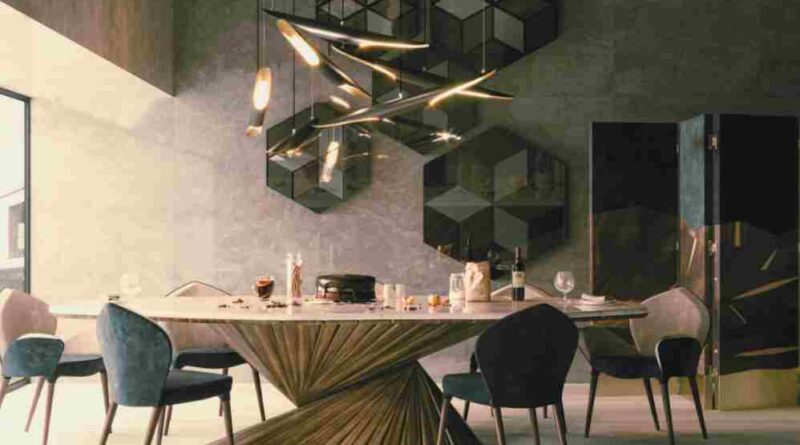Sensory Design: How Sound, Scent & Texture Shape Our Well-Being
In an increasingly digital, fast-paced world, design has transcended the visual. We’re no longer just looking at beautiful spaces—we’re feeling them, breathing them in, and hearing their subtle messages. Enter sensory design, the evolving practice of intentionally curating environments to engage not just the eyes but the full spectrum of human senses. Sound, scent, and texture have emerged as silent but powerful players in how we experience space—and, perhaps more importantly, how we feel within it.
This is about more than good aesthetics. It’s about creating spaces that heal, soothe, energize, and nurture. In a world teetering on burnout, sensory design is a quiet revolution. It’s designing for the soul.
The Rise of Sensory Intelligence
For centuries, design was predominantly visual. We praised architecture for its grandeur, interiors for their color schemes, and furniture for its form. But as neuroscience and psychology began peering into how the human brain processes space, a new understanding emerged: our experience of the world is deeply multisensory.
Our bodies are always listening, always feeling. A faint scent can unlock a memory. The texture of a fabric can calm a restless mind. A subtle background hum can either relax or irritate. Sensory design acknowledges these truths and begins from a new premise: we design for the body, not just the eyes.
Why Senses Matter in Design
Think of your favorite place—maybe it’s a café, your grandmother’s living room, or a sunlit reading nook. What makes it special likely isn’t just how it looks. It might be the soft hum of music in the background, the scent of fresh coffee or aged wood, or the way the cushions feel under your fingertips.
These small, sensory cues have a massive impact on our nervous system. They shape how safe, relaxed, or stimulated we feel. Over time, they even influence our behavior, our sleep, and our emotional well-being. Sensory design taps into that hidden intelligence, shaping environments that make us feel more human.
Sound: The Invisible Mood Setter
Let’s start with sound—arguably the most overlooked design element. We often notice noise only when it becomes a problem. A buzzing HVAC unit, footsteps above your ceiling, or echoey acoustics in a restaurant can all quickly ruin an otherwise well-designed space.
But when used intentionally, sound becomes a powerful emotional tool.
Ambient music in spas isn’t random—it’s chosen for its ability to lower heart rate and reduce cortisol levels. Offices that integrate acoustic zoning—using materials that absorb noise—see improved focus and employee satisfaction. Hospitals that use sound masking reduce patient stress and even speed up healing.
Even silence, or the careful design of acoustic stillness, is an art. Spaces that offer sonic calm have become sacred havens in a noisy world.
Soundscaping in Action
Consider the “biophilic” trend—bringing nature indoors. It’s not just about plants. Designers are now integrating the gentle sounds of rain, rustling leaves, or distant ocean waves to create emotionally resonant interiors. These natural soundscapes tap into deep evolutionary wiring, reminding us of safety, abundance, and calm.
Museums, hotels, and retail spaces are also curating signature soundtracks to shape how people move and feel. In one experiment, classical music in a wine store led shoppers to buy more expensive bottles. Sound doesn’t just decorate space—it shapes decision-making.
Scent: The Emotional Trigger
Of all the senses, scent is most directly tied to memory and emotion. One whiff of sunscreen and you’re transported to a childhood beach vacation. The smell of cinnamon might remind you of the holidays. Unlike visual or auditory stimuli, scent bypasses the rational brain and speaks straight to the emotional core.
That’s why scent design has exploded across industries. High-end hotels now curate signature scents to create brand identity and trigger emotional loyalty. Luxury retailers diffuse carefully chosen fragrances to encourage longer browsing. Even hospitals are exploring scent to reduce patient anxiety.
In the home, scent is increasingly becoming part of wellness rituals. Essential oil diffusers, incense, and naturally fragranced candles are chosen not just for aesthetics but for their mood-shifting potential. Lavender for sleep, eucalyptus for clarity, rose for emotional openness.
The Science of Aromatherapy Meets Design
Aromatherapy, once relegated to alternative wellness circles, is now entering mainstream design. Studies show that certain scents—like bergamot, ylang-ylang, and frankincense—can reduce anxiety and improve focus. Interior designers are starting to partner with scent consultants to incorporate olfactory layers into their projects.
This trend is also finding its way into public spaces. Airports, for instance, are experimenting with calming scents at security checkpoints. Retail stores are using energizing citrus to awaken and motivate shoppers. We’re beginning to understand: scent is not just an accessory; it’s a strategy.
Texture: The Language of Touch
While visual design tells you how a space looks, texture tells you how it feels. And in many ways, feel matters more.
In an era of constant screen time and digital detachment, tactile experiences have become a form of emotional grounding. Think of the comfort of a chunky knit throw, the coolness of marble under your hand, the reassuring grain of unfinished wood.
Textures speak to us on a primal level. They bring us into the present moment, reminding us of our physical body in physical space. That awareness is a cornerstone of well-being.
The Rise of “Tactile Wellness”
Designers are now paying more attention to how materials feel. Upholstery is chosen not just for color but for softness and warmth. Flooring materials are selected for how they interact with bare feet. Even wall coverings and hardware are being reevaluated through the lens of touch.
This tactile awareness is especially important in spaces where comfort and calm are the goal—bedrooms, therapy offices, meditation rooms. Soft, forgiving textures can subconsciously signal safety, while harsh, slick surfaces can create low-grade stress.
Even in public architecture, you’ll now find handrails made of wood instead of metal, curved corners instead of sharp edges, and textured walls that invite touch. It’s a quiet shift toward spaces that feel more humane.
Sensory Design and Mental Health
The pandemic sparked a global reevaluation of how environments affect mental health. Suddenly, we were spending more time indoors than ever, and the details of our surroundings began to matter more. Was the lighting soothing or jarring? Was the background noise energizing or distracting? Did the air smell fresh or stale?
Sensory design offers a blueprint for healing. By creating environments that support the nervous system, we reduce the mental and emotional load of everyday life. We sleep better. We focus longer. We feel more grounded.
Mental health professionals are starting to take notice. Sensory rooms are being incorporated into therapy centers and schools to help people self-regulate. Trauma-informed design is using soft lighting, calming textures, and warm scents to create spaces of emotional safety. The line between design and therapy is blurring—and that’s a good thing.
The Multisensory Home
The home of the future isn’t just smart—it’s sensorially intelligent. Instead of focusing solely on automation and tech, forward-thinking designers are considering how to create emotionally supportive environments.
This might look like acoustic panels disguised as art, circadian lighting that mimics the natural rise and fall of the sun, or a scent diffuser programmed to release calming aromas before bed.
It could also mean zoning your home for different emotional needs. A reading nook with soft textures and quiet background music for calm. A kitchen with invigorating scents and crisp lighting for energy. A bedroom layered with natural fabrics and personalized scents for rest.
We’re no longer designing for “looks good”—we’re designing for “feels right.”
Sensory Design in the Workplace
Workplace design is undergoing a massive shift as well. With hybrid work models becoming the norm, companies are rethinking what the physical office should provide. The answer? Sensory nourishment.
This means more natural light, acoustic privacy, and air that actually smells pleasant. It means lounge areas with soft furnishings and restorative textures. It means scent zones that subtly support different moods: peppermint for focus, lavender for decompression.
Studies show that employees are more productive, creative, and emotionally resilient in environments that stimulate the senses in positive ways. Sensory design isn’t a luxury—it’s a business strategy.
Hospitality, Retail, and the Sensory Edge
In a saturated market, hotels, restaurants, and shops are realizing that experience is the new currency. And experience is, by nature, sensory.
Luxury hotels now design signature sensory experiences—from curated playlists and signature room scents to tactile details in bedding and bath products. Restaurants are playing with sound and texture as much as flavor, using ambient noise and sensory plating to enhance dining. Retail spaces are moving beyond sightlines to scent mapping and sound zoning.
Consumers may not always be able to articulate why a space felt magical—but their bodies know. And they come back for that feeling.
Sensory Equity and Inclusive Design
There’s another layer to sensory design that’s gaining traction: inclusion. Not everyone experiences sensory input the same way. People with autism, ADHD, PTSD, or sensory processing disorders often find traditional environments overwhelming or inaccessible.
Sensory design, when done thoughtfully, can be a bridge—not a barrier. It’s about creating environments that offer choice and control over sensory input. Quiet zones, dimmable lighting, scent-free options, and tactile diversity are no longer niche—they’re essential.
In this way, sensory design becomes not just a wellness tool, but a social responsibility.
Designing Your Own Sensory Sanctuary
You don’t need to be an architect or interior designer to start playing with sensory design. Start with awareness. Tune in to how you feel in different spaces. What sounds energize or irritate you? Which scents make you feel calm or alive? What textures bring you comfort?
Then, slowly begin to layer those insights into your personal space. Swap harsh lighting for warm bulbs. Introduce a scent ritual. Add tactile layers—blankets, cushions, natural materials. Play with playlists depending on the mood you want to evoke.
Design becomes healing when it meets you where you are.
The Future Is Felt
As we move into an era of design that prioritizes well-being, sensory design will only grow in relevance. It’s not about gimmicks or trends—it’s about deepening our relationship with the spaces we inhabit. It’s about reminding ourselves that we are not just thinking minds, but sensing bodies.
When sound, scent, and texture align in harmony, something magical happens: we return to ourselves. We feel safe. We breathe more deeply. We live more fully.
And that, ultimately, is the true purpose of design—not to impress, but to embrace.
Disclaimer
The information and content shared on digitalgithub.com — including articles, blogs, news, guides, and other resources — is intended for general informational and educational purposes only. We do not guarantee the completeness, reliability, or suitability of any information. Always seek the guidance of a qualified professional before making decisions based on the information you read. Use this site at your own risk.

